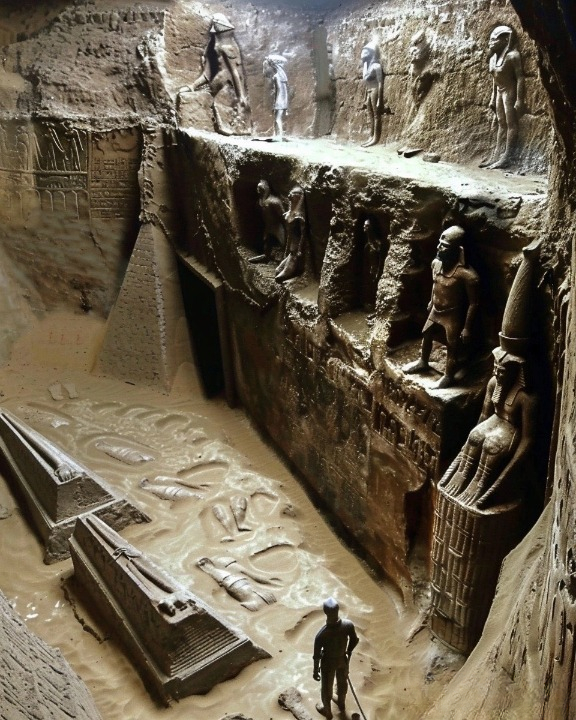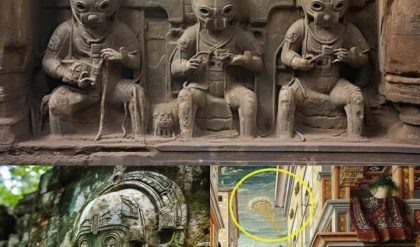The Sahara Desert, the world’s largest hot desert, is a vast expanse of arid land that stretches across North Africa, covering an area almost as large as the United States. While the Sahara is often perceived as a barren and lifeless region, it conceals a wealth of incredible secrets beneath its sands. From ancient rivers and lost civilizations to surprising ecological treasures, the Sahara is a landscape filled with mystery and wonder. Here are some of the most incredible facts about what lies hidden under the sands of the Sahara.

1. Ancient River Systems
Beneath the Sahara’s dunes, remnants of ancient river systems tell the story of a very different landscape. Thousands of years ago, the Sahara was a lush, green region with flowing rivers, lakes, and abundant vegetation. Satellite imagery and geological studies have revealed the courses of these ancient rivers, which once supported thriving ecosystems and human populations. The most famous of these is the Tamanrasset River, a vast waterway that rivaled the Nile in size. Today, these ancient rivers are buried under layers of sand, but their traces are still visible from space.
2. Fossils of Prehistoric Creatures
The Sahara is also home to a treasure trove of fossils, including the remains of prehistoric creatures that once roamed the region. Among the most astonishing finds are the fossils of dinosaurs, such as the fearsome Spinosaurus, which lived in the area during the Cretaceous period. These discoveries have provided valuable insights into the prehistoric life that existed in what is now one of the driest places on Earth. Additionally, the desert has yielded fossils of ancient fish, crocodiles, and other creatures, offering a glimpse into the Sahara’s distant past as a thriving habitat.

3. Lost Civilizations and Ancient Cities
The sands of the Sahara have also preserved the remnants of ancient civilizations that once flourished in this region. Archaeologists have uncovered evidence of complex societies, including the Garamantes, who established a powerful kingdom in what is now Libya. The Garamantes were skilled engineers, building an extensive network of underground irrigation channels known as foggaras to sustain their agriculture in the harsh desert environment.
In addition to the Garamantes, the Sahara is dotted with the ruins of ancient cities and trading posts that played crucial roles in the trans-Saharan trade routes. These cities were hubs of commerce, connecting sub-Saharan Africa with the Mediterranean world and beyond, trading in gold, salt, ivory, and other valuable goods.
4. The Eye of the Sahara (Richat Structure)
One of the most enigmatic features of the Sahara is the Eye of the Sahara, also known as the Richat Structure. This massive, circular geological formation is located in Mauritania and is visible from space. Measuring about 40 kilometers (25 miles) in diameter, the Eye of the Sahara has puzzled scientists for decades. Originally thought to be the result of a meteorite impact, it is now believed to be a deeply eroded dome, though its precise origins remain a subject of debate. Some even speculate that it could be the remains of the fabled lost city of Atlantis.
5. Subterranean Aquifers and Water Sources
Despite its arid surface, the Sahara conceals vast reserves of water beneath its sands. These subterranean aquifers hold ancient groundwater, some of which has been trapped underground for thousands of years. This fossil water is a vital resource for the desert’s inhabitants, providing a lifeline in an otherwise inhospitable environment.
The Great Man-Made River project in Libya is one of the most ambitious attempts to tap into these hidden water sources. It involves a vast network of pipes and reservoirs that transport water from deep underground aquifers to the surface, supplying cities and agricultural areas with precious water.
6. Ancient Art and Rock Carvings
Scattered throughout the Sahara are thousands of ancient rock carvings and paintings, known as petroglyphs, that provide a glimpse into the lives of the people who once inhabited the region. These artworks depict scenes of hunting, dancing, and daily life, as well as animals that are no longer found in the Sahara, such as giraffes, elephants, and hippos. The petroglyphs, some of which are over 10,000 years old, are a testament to the Sahara’s rich cultural heritage and its significance as a cradle of human civilization.
7. Mysterious Megalithic Structures
The Sahara is also home to mysterious megalithic structures, some of which predate the pyramids of Egypt. These stone structures, often arranged in circles or rows, have been found in several locations across the desert. Their purpose remains unclear, but they are believed to have served as burial sites, astronomical markers, or ceremonial centers. The most famous of these is the Nabta Playa, located in southern Egypt, which features a stone circle that may have been used to track the movements of the stars.
8. The Changing Climate of the Sahara
The Sahara’s climate has not always been as harsh as it is today. About 10,000 years ago, the region experienced a period known as the African Humid Period, during which it was a verdant landscape with abundant rainfall. This period allowed for the development of human settlements and the flourishing of wildlife. However, over time, the climate shifted, leading to the gradual desertification of the region. Understanding the Sahara’s climatic history is crucial for studying the broader patterns of climate change and its impact on human societies.
Conclusion
The Sahara Desert, often perceived as an empty and desolate expanse, is in fact a repository of incredible secrets and treasures. From ancient river systems and prehistoric fossils to lost civilizations and mysterious geological formations, the Sahara is a landscape that continues to reveal its hidden wonders. As researchers continue to explore this vast desert, they are likely to uncover even more remarkable facts about the history and mysteries buried beneath the sands.





